#macintosh system 1
Video
- W e l c o m e t o M E A T S P A C E O S -
I was lucky enough to get the chance to work on an interstitial for a local film festival for one of my college classes, and after a bunch of excessive work, here it is!
(Music: Global Lunch by James Ferraro)
It’s definitely weirder than my usual stuff, but I still hope you enjoy-
( ᐛ )
#my art#vaporwave#old internet#film festival#interstitial#windows 98#windows xp#mac os 8#mac os x#macintosh system 1#meatspace#webcore#blender#ascii art#pixel art#this took SO LONG to make.
37 notes
·
View notes
Text

Clock Signal 2024-01-22 released - A latency-hating emulator of 8- and 16-bit platforms: the Acorn Electron, Amstrad CPC, Apple II/II+/IIe and early Macintosh, Atari 2600 and ST, ColecoVision, Enterprise 64/128, Commodore Vic-20 and Amiga, MSX 1/2, Oric 1/Atmos, early PC compatibles, Sega Master System, Sinclair ZX80/81 and ZX Spectrum.
17 notes
·
View notes
Text
𝟮𝟭 𝗳𝗮𝗰𝘁𝘀 𝗮𝗯𝗼𝘂𝘁 𝗦𝗰𝗼𝘁𝗹𝗮𝗻𝗱 𝘆𝗼𝘂 𝗱𝗶𝗱𝗻'𝘁 𝗸𝗻𝗼𝘄:
1. Scotland has over 790 islands, but only about 130 are inhabited. The largest inhabited island is Lewis and Harris.
2. Edinburgh was the first city in the world to have its own fire brigade, established in 1824.
3. Scotland's national animal is the unicorn, symbolizing purity, innocence, and power in Celtic mythology.
4. The shortest scheduled flight in the world is in Scotland. The flight between Westray and Papa Westray in the Orkney Islands lasts just around one minute.
5. Scotland is home to the oldest tree in Europe: A twisted yew tree in Fortingall that is estimated to be between 3,000 and 9,000 years old.
6. Shetland has the highest density of otters in Europe, with around 1,000 otters living in the wild.
7. The raincoat was invented by Charles Macintosh, a Glaswegian, in 1824, revolutionizing outdoor wear with his waterproof fabric.
8. Scotland has its own legal system, separate from England and Wales, with its roots in Roman law and influenced by other legal traditions, including French law.
9. The Encyclopedia Britannica was first produced in Scotland in 1768, in Edinburgh, to be precise.
10. The world’s first color photograph was taken in Scotland: In 1861, James Clerk Maxwell presented a color photograph of a tartan ribbon.
11. Golf originated in Scotland, with the game being played on Musselburgh Links in 1672, which is recognized as the world’s oldest golf course.
12. Scotland’s national dish is haggis, a savory pudding containing sheep's heart, liver, and lungs, mixed with onions, oatmeal, suet, spices, and salt, encased in the animal's stomach.
13. The first official international football (soccer) match was played in Scotland between Scotland and England in 1872.
14. Scotland has its own currency: Scottish banks issue their own banknotes, which are legal currency throughout the UK, though they might be met with confusion outside Scotland.
15. Edinburgh was named the first UNESCO City of Literature in 2004, recognizing its strong literary heritage.
16. St. Andrew’s Day on November 30th is a national holiday in Scotland, celebrating Saint Andrew, the patron saint of Scotland.
17. The Old Course at St. Andrews is considered the "home of golf" and has been played on since the 15th century.
18. Skara Brae on Orkney is older than Stonehenge and the Great Pyramids, making it one of the oldest agricultural villages in the UK.
19. The largest secondhand bookshop in Scotland, Leakey’s Bookshop in Inverness, is housed in an old church and features a wood-burning stove in the center.
20. The Scots Pine is Scotland’s national tree, symbolic of its ancient Caledonian forests.
21. Scotland is famed for its "right to roam", where people can access most land and inland water for recreation, as long as they do so responsibly under the Scottish Outdoor Access Code.
13 notes
·
View notes
Text
Chapter 1. : The New Normal.
Scrape.
Click.
Scrape.
Click.
Galaxies to my sides. Before me floor. It appears in the void as needed. I can see patterns in the stars that give way to fractals. Like real space, they are unending. A place we call The House.
Scrape.
Click.
Scrape.
Click.
My mentors claws gently tap the marble tiles as she saunters slowly down the corridor of The House. I float quietly to her right. The airs of reverence hang over my head far heavier than my own hat.
"Billie," coos she, "How stands The Game?"
She has her own way of talking. It makes sense on the inside. I suppose you'd need to be there. She's asking the system's vitals.
"Everything Is Accounted For, Mother." I abide by her rules and respond in her own tounge. She nods. My mentor, Cube, is the systems guardian. A seraphim. A real one. Her snow white feathers glimmer with the light of holy embers. She keeps her eyes covered at all times with the smaller wings on her head. She doesn't need them to see. What a high bar to set for a little triangle like me. How she expects me to follow her in her talonsteps is beyond us.
"Then Your First Mission Begins, O Tetrahedron. Go forth and make the control room more comfortable."
"For our host?" I grumble.
"For our host." she nods.
A snap of my fingers. Darkness. The control room has a long history of this... funk. I already decided I'd spruce it up in here but it's hard to polish a turd, pardon my french. I readjust my bow as I take a deep inhale to ready myself mentally. A long exhale follows.
The Darkness is in fact a great tunnel. Each noise I make echos deep into its caverns. Its wet and squishy caverns. The Tunnel is lined with flesh, as it is alive. There are eyes not unlike my own embedded into the walls and the others cannot see them. They stare into my own eyemouth with unnerving silence.
A green glow ignites from inside of me from between my very bricks and down my arm, blazing into an emerald green fire. With it, the shining of gold. My scythe. The metal engraving on it is of a six fingered hand and a broken heart. A reminder of whom death did me part. I take the scythe in my grasp and swing it as Grimm has shown me. Slicing through our shared reality and repainting it in the image most fitting. The tunnel is replaced, as with brushstrokes, with a room.
A comfortable little room with many plushies and a macintosh computer. It's not what I want it to be yet, but what it is. Is our hosts childhood bedroom. It is the place that right now. It needs.
Emerald Sparks die down. I sit gently upon the carpet.
"I am a friend, Shadow Girl. You can talk to me."
I can't see her. Or hear her. But I can feel her. And I know she knows something important.
7 notes
·
View notes
Note
Hi!! I haven't been keeping up with six as much recently, could you explain the UK standardising covers thing a bit more?
Hey! Yes! However I am going to slightly hijack this ask and give a broader “UK alt system 101” because I’ve been getting a lot of asks about it recently.
First covers (fully standardized)
Prior to lockdown and with the first cast returning from lockdown, UK casts of Six would just choose alt covers based on the queens they had and what worked best. Saw combos like A/P, S/H, B/C; A/C, B/H, S/P; A/H, B/C, S/P. Starting in fall 2021, every new UK cast has used an alt system with A/C, B/H, and S/P, and then swing(s).
Second covers (not standardized)
Prior to Covid they had used two different second cover systems:
#1. What I call the "consistent" cover system, where if someone is first cover B/C then someone else is going to be second cover B/C and someone else third B/C. This was used by the 2019-21 West End cast. Example:
Zara MacIntosh: 1st A/H, 2nd B/C, 3rd S/P
Cherelle Jay: 1st B/C, 2nd S/P, 3rd A/H
Hana Stewart: 1st S/P, 2nd A/H, 3rd B/C
#2. What I call the "scrambled" cover system, where if someone is first cover B/C then one of the other alts is second cover B/? and the other is C/?. This one was used by the 2019 West End alts...
Courtney Stapleton: 1st A/P, 2nd S/C, 3rd B/H
Vicki Manser: 1st B/C, 2nd H/P, 3rd A/S
Grace Mouat: 1st S/H, 2nd A/B, 3rd C/P
...and the 2019-22 UK Tour alts:
Cassandra Lee: 1st A/C, 2nd S/H, and 3rd B/P
Jennifer Caldwell: 1st B/H, 2nd A/P, 3rd S/C
Harriet Watson: 1st S/P, 2nd B/C, 3rd A/H
This system is generally better from a coverage/management perspective, which I talked about here.
When they came back from lockdown they initially seemed to have standardized to the consistent system. The 21-22 WE followed it:
Paisley Billings: A/C, S/P, B/H
Danielle Rose: B/H, A/C, S/P
Roxanne Couch: S/P, B/H, A/C
as did the 22-23 UKT, formally anyway (may have followed a different one informally):
Grace Melville: A/C, B/H, S/P
Leesa Tulley: B/H, S/P, A/C
Natalie Pilkington: S/P, A/C, B/H
but the 22-23 WE started following a scrambled again:
Monique Ashe-Palmer: A/C, B/P, S/H
Danielle Rose: B/H, A/S, C/P
Leah Vassell: S/P, C/H, A/B
and the 23-23 UKT now is too:
Ellie Jane Grant: A/C, P/?, S/?
Izi Maxwell: B/H, S/C, A/P
Tamara Anne Morgan: S/P, A/?, C/?
I'm guessing they will try to continue using scrambled in the future because of the coverage benefits, but we'll see.
Swings
The West End uses two swings. Each of them have three primary covers, but also cover the other three commonly enough as needed.
The UK Tour just has one swing, who covers all six roles technically equally (but just like with all prior swings there does still seem to be some sort of unofficial priority/preferred roles).
Costumes
The alts have principal-style costumes for their first covers. If/when they cover 2nd or 3rd covers, they wear an alt costume:

(Pictured: Paisley Billings, Danielle Rose, Leah Vassell)
A/C wears teal, B/H wears orange, and S/P wears pink. There's only one consistent variation: teal is always pants w/ peplum, orange is always pants w/ peplum, and pink is always the standard A/H.
The swings wear regular swing costumes for all six costumes. Those are black and silver:

(Pictured: Rachel Rawlinson, Esme Rothero; Rachel Aragon photo by Pamela Raith)
The single UK Tour swing wears silver. For the West End, the second alt is added in black. They each get multiple variations as pictured, although for the UK Tour the swing does not have a Boleyn skirt. These Cleves costumes also don’t have a reveal.
28 notes
·
View notes
Text
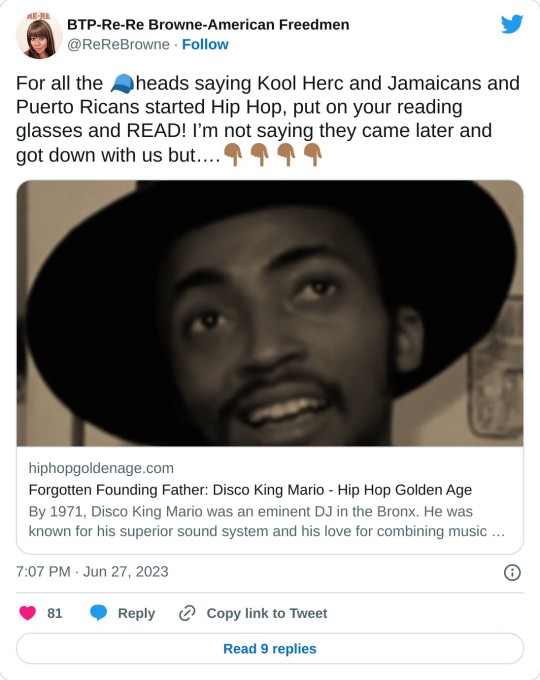

By 1971, Disco King Mario was an eminent DJ in the Bronx. He was known for his superior sound system and his love for combining music and a good time. Mario came up during the era where you had to be tough enough to bring your equipment out, because of how prevalent gangs and violence were in the Bronx in the early 70s. But the Disco King was respected all over, from neighborhood mothers to the grimiest gangsters. He is a major part of the creation of Hip Hop.
youtube
Disco King Mario was born in North Carolina in 1956 but moved to the Bronxdale Housing projects in order to escape working cotton and tobacco fields. He was an original member of the Black Spades, which is how his connection with Afrika Bambaata came about. Mario played whatever he wanted to play. He wasn’t playing breakbeats, but more uptempo disco. He was also a ladies man and was always fly, but still he was nobody to mess with.
The Disco King gained popularity by piecing together the best sounding system in the Bronx, and for the super live jams he would throw. DJ Kool Herc and Afrika Bambaata were both seen in attendance at these jams. Mario is credited for helping the culture spread because of his ability to manipulate people (in a good way) in order to allow them to use their venues for a party. He was able to lock down many venues and schools that other DJ’s couldn’t get.

With his connections, he would start to bring Afrika Bambaata along and allow Bam to assist him DJ. Disco King Mario is responsible for Afrika Bambaata’s early popularity by loaning him equipment and allowing him to play at all the different schools and parks he could get access to. He is also responsible for recognizing and grooming Busy Bee Starski, one of the best party rockers of that time.
“I went from Disco King Mario to Breakout,” said Busy Bee Starski in Yes Yes Y’all: The Experience Music Project Oral History Of Hip Hop’s First Decade. In that book, members of the Funky 4+1 also tell the story of how Disco King Mario saved Afrika Bambaata from losing a battle with them, by loaning Bam his amplifier:
youtube
Busy Bee: “It was Breakout and Bambaataa, and I was rappin’ with Breakout at that time. And Bambaataa needed some help with Breakout and Baron, I’m tellin’ you [laughing]! So Bambaataa had to call and ask Mario. He needed an amp. Mario said, “What happened?” He said, “I’m going to battle Breakout. He said, “Oh yeah? Then you need the Macintosh [amplifier]. You need this.”
DJ Baron: “Afrika Bambaataa was on one side of the gym, and we was on the other. The place was jam-packed. But Bambaataa had one up his sleeve: Disco King Mario had loaned Bam a power amp. We were going back and forth, and all of a sudden you couldn’t hear us no more [laughs], ‘cause Bam borrowed his amp from Mario and blew us out of the water, just drowns us out totally…”
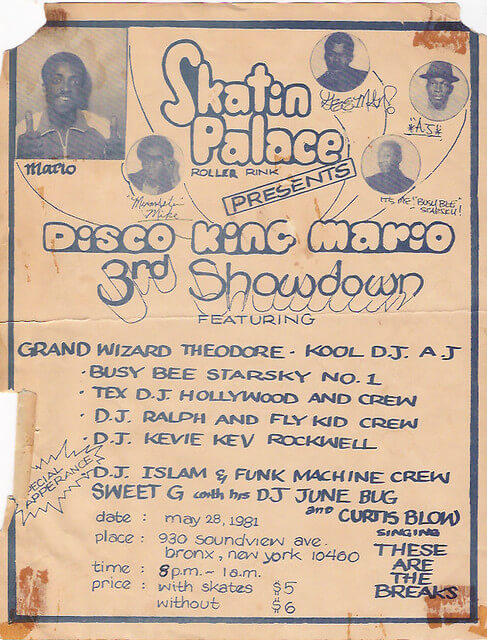
Disco King Mario died at the early age of 38, after a long battle with drugs during the ’80s. Many pioneers say that his early death is the reason for him being virtually written out of Hip Hop history. Others wish that more of the popular pioneers that are still around would acknowledge and pay homage to him more.
[Raises glass in the air]
So, here’s to Disco King Mario for helping lay the foundation for the Hip Hop culture. May he Rest in Peace.
#Forgotten Founding Father: Disco King Mario - Hip Hop Golden Age#disco#hip hop#Black Music#King Mqario#bronx#nyc#Youtube
18 notes
·
View notes
Text
Apple HyperCard (1987) with Computer Chronicles clip featuring the creator, Bill Atkinson from Apple
Wikipedia -
HyperCard is a software application and development kit for Apple Macintosh and Apple IIGS computers. It is among the first successful hypermedia systems predating the World Wide Web. HyperCard combines a flat-file database with a graphical, flexible, user-modifiable interface.
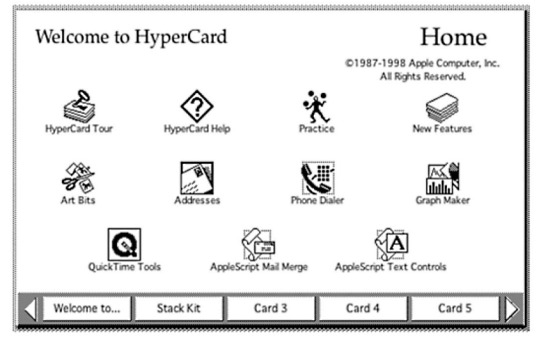

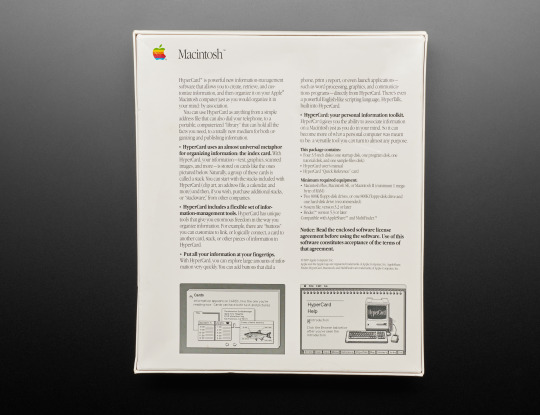
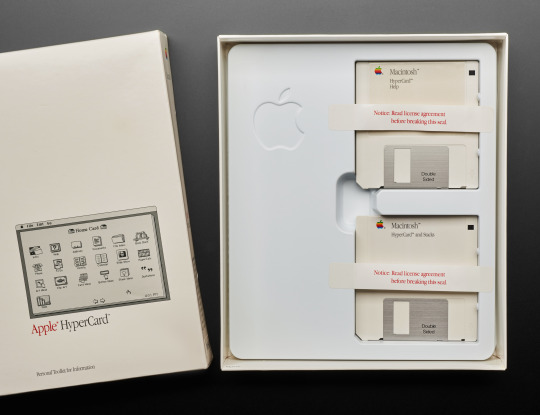
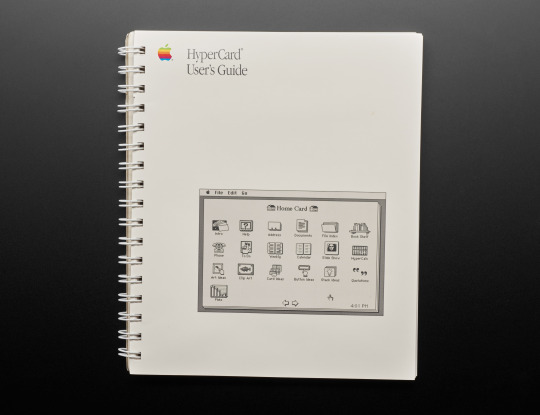

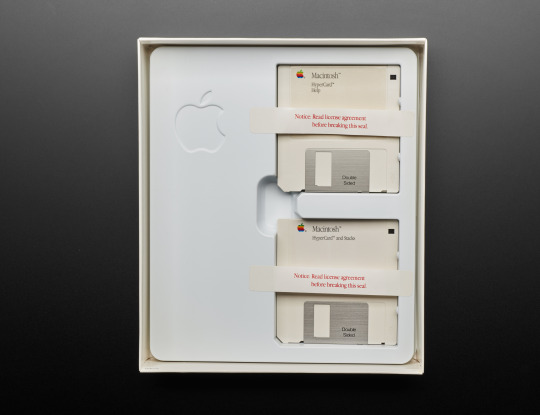




HyperCard combines a flat-file database with a graphical, flexible, user-modifiable interface. HyperCard includes a built-in programming language called HyperTalk for manipulating data and the user interface.
This combination of features – a database with simple form layout, flexible support for graphics, and ease of programming – suits HyperCard for many different projects such as rapid application development of applications and databases, interactive applications with no database requirements, command and control systems, and many examples in the demoscene.
HyperCard was originally released in 1987 for $49.95 and was then included for free with all new Macs sold. It was withdrawn from sale in March 2004, having received its final update in 1998 upon the return of Steve Jobs to Apple. HyperCard runs in the Classic Environment, but was not ported to Mac OS X.
HyperCard influenced the development of the Web in late 1990 through its influence on Robert Cailliau, who assisted in developing Tim Berners-Lee’s first Web browser. Javascript was inspired by HyperTalk.
Video and more
An introduction to Apple's Hypercard. Guests include Apple Fellow and Hypercard creator Bill Atkinson.
https://www.youtube.com/watch?v=FquNpWdf9vg
https://blog.adafruit.com/2014/06/18/hypercard/
Apple Fellow and Hypercard creator Bill Atkinson
https://en.wikipedia.org/wiki/Bill_Atkinson
https://twitter.com/billatk
https://www.youtube.com/@photocardapp
CircuitPython Your Own Adventure
https://learn.adafruit.com/circuit-python-your-own-adventure?view=all
Tons of HyperCard on the Adafruit blog!
https://blog.adafruit.com/?s=hypercard
HyperCard, the missing link to the Web
https://blog.adafruit.com/2021/06/07/34-years-of-hypercard-the-missing-link-to-the-web-hypercard-vintagecomputing-arstechnica/
The Library of Congress and HyperCard
https://blog.adafruit.com/2021/12/15/the-library-of-congress-and-hypercard-vintagecomputing-digitalpreservation-librarycongress/
DitherPaint: a 1-bit, browser-based drawing application
https://blog.adafruit.com/2021/06/09/ditherpaint-a-1-bit-browser-based-drawing-application/
Proposed Commercials featuring Mac team Members in October 1983, Full Demo Reel
https://blog.adafruit.com/2019/11/24/proposed-commercials-featuring-mac-team-members-in-october-1983-full-demo-reel-andyhertzfeld-apple/
Andy Hertzfeld has a YouTube channel
https://blog.adafruit.com/2019/07/20/andy-hertzfeld-has-a-youtube-channel-and-its-great-andyhertzfeld-billatk-susankare/
Apple Macintosh - Your Tour of HyperCard (1991) Apple Computer
https://www.youtube.com/watch?v=tx_WCIAM4bA
Explore Magic Cap, a smartphone OS from a decade before the iPhone
https://learn.adafruit.com/magic-cap-the-smartphone-os-from-the-90s?view=all
22 notes
·
View notes
Text
So, we're 51 chapters deep into my Conan reread, which is five volumes and about a year of publication. I thought this would be a great spot to pause for a minute.
Right now, this project has parsed through 14 cases. 12 are 100% essential, 1 is 100% non essential, and 1 is still up in the air (the "Once-A-Month Present Threat Case", otherwise known as the "Ran is suspicious of Shinichi for the first time" case).
Assuming that that up-in-the-air case isn't canonical, our current statistics are quite interesting:
A minimum of 34 days have passed over the course of the story.
Over that time, Conan has encountered 13 deaths.
Which works out to approximately one body every three days on average.
(If we include the case I'm uncertain about, those numbers become 65 days, 13 deaths, for an average of one body every five days.)
Out of those 14 cases, a whole five-- that's over a third!-- feature 0 deaths!
Finally, I want to end this year wrap up with some fun facts.
When Detective Conan began its run in January 1994, a lot of things didn't exist that exist now. In the spirit of the memorable case about the guy locked in a room writing novels with plots that could have been solved easily by a cell phone, a classic and memorable Conan case, let's talk about things introduced to the world over the past year of Conan cases that we've looked at.
In January 1994, Chapter One of Detective Conan is published. I didn't exist. Fruitopia didn't exist. Reese's Puffs didn't exist. By the end of the year, all three of these things did exist. The W-VHS system for Japanese Hi-Vision television (early analog HD) was introduced in 1994. In computers, the HP 200LX personal assistant was released that year. The Macintosh Quadra 630 (weighing in at 19lbs, with a whole 4MB of memory!) was the least expensive computer in the Mac lineup for $1,199 USD ($2,192 2022 USD equivalent!). If you wanted a mobile phone that released in 1994, you'd be looking at the sick Nokia 2010 or the Nokia 2110. Amazon was founded between the publication of the takoban volumes 1 and 2. This is the world that Conan Edogawa was "born" into.
28 notes
·
View notes
Text
Apple Inc.
Apple Inc. was founded by Steve Jobs, Steve Wozniak, and Ronald Wayne on April 1, 1976, in Cupertino, California. The company's initial goal was to develop and sell personal computers. Over the years, Apple has evolved into one of the most influential and successful technology companies globally. With a commitment to innovation and design, Apple has expanded its product range to include iconic devices such as the iPhone, iPad, Macintosh computers, and Apple Watch. The company's present perfect journey has seen it revolutionize the consumer electronics and software industries, setting new standards for user experience and technological integration.
Important Achievements:
• Apple has revolutionized its product lineup by transitioning from Intel processors to its custom-designed Apple Silicon chips. This strategic move, initiated in 2020, has allowed Apple to exert greater control over the integration of hardware and software, resulting in impressive performance improvements and energy efficiency across Mac devices.
• Implementation of App Tracking Transparency: In 2021, Apple implemented App Tracking Transparency in iOS 14.5, a significant achievement that reflects the company's unwavering commitment to user privacy. This feature empowers users to control and manage which apps can track their activities across various platforms, setting a new standard for digital privacy within the technology industry.
Recent Achievements:
• Apple has been advancing its Apple Silicon technology, with ongoing efforts in designing and optimizing custom processors. The company has been progressively enhancing performance, power efficiency, and overall user experience through iterative updates, reinforcing its commitment to pushing the boundaries of hardware innovation.
• Iterating iOS with Privacy Enhancements: In recent years, Apple has been consistently iterating its iOS operating system with a focus on privacy enhancements. The company has been actively refining and introducing features that give users more control over their personal data, demonstrating an ongoing commitment to fostering a secure and private digital environment.
López moreno Yareni Dessiré.
Téllez Vazquez Claudia Tonantzin.
Torres Rodríguez Lizeth Danae.
2 notes
·
View notes
Text

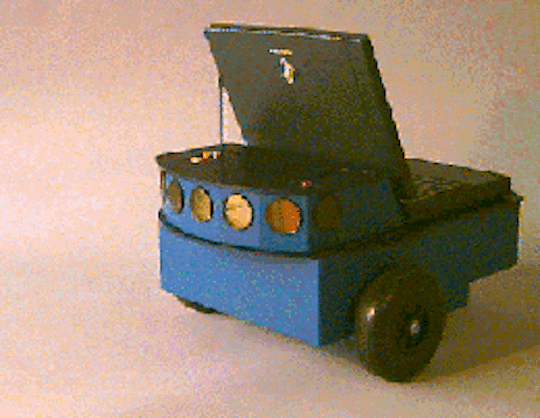
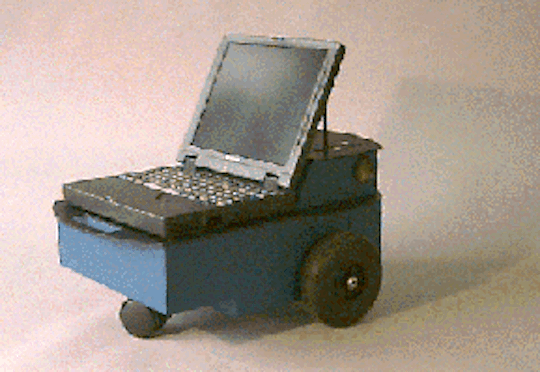
Pioneer 1 Mobile Robot (1996) by Kurt Konolige (SRI) and Grinnell More of Real World Interface, Inc. Pioneer 1 is a production version of the ERRATIC platform. Priced at under $2,500, universities everywhere can now afford to teach robotics. It combines differential wheel drive with incremental encoders for accurate turning resolution. Its 7 sonar, multiple I/O ports and removable nose, support custom sensor input and attachments. Based on the MC68HC11 micro-controller, it provides onboard Saphira software libraries of robot behaviors from SRI's Artificial Intelligence Center, and a suite of directly accessible low-level commands. The Pioneer supports Rodney Brooks’ Lucid Common Lisp and the L System development environment with multi-threaded extensions. The Mars (Multiple Agency Reactive System) provides a number of L functions supporting message-passing between threads. The L cross compiler enables development on Macintosh Common Lisp (MCL), before downloading it to the L System runtime. “The new Pioneer 1 robot is designed to break the price barrier that until now has made sophisticated robots a luxury in labs, classrooms and high-tech homes. Multi-agent research suddenly becomes affordable, since four of these robots cost about the same as one other of comparable capabilities.” The Pioneer team comfortably won the AAAI96 Robotics "Call a Meeting" competition where a robot has to find an empty conference room, notify participants, and then report back. In an ingenious use of parallelism, the task was divided efficiently between three communicating robots.
18 notes
·
View notes
Text
Tell Me About Designer Susan Kare
Editor’s Note: This is an experimental post written with the assistance of AI software, Chat GPT. The content was vetted for accuracy and revised for style.
Susan Kare is considered a pioneer in the field of computer interface design, best known for her work at Apple Computer during the 1980s, where she designed interface elements for the original Macintosh computer. These elements include the original Macintosh typeface, Chicago, as well as many of the icons and user interface elements that were used in the Macintosh operating system. Kare's work has had a significant impact on the design of user interfaces, and her design elements are still in use today in various forms. (1)
Kare's work on the Macintosh interface was far-reaching and had a big impact on the design of user interfaces. Here are a few examples:
The original Macintosh typeface used in the Macintosh operating system and is still used in various forms today
The "Happy Mac" icon, which was the icon that appeared on the Macintosh screen when the computer was turned on and the operating system was loading (2)
The "Command" key icon still used on Apple keyboards to this day to indicate the command key (3)
The "Paint Bucket" and "Paintbrush" icon used in the Macintosh program MacPaint (3)
The "Lasso" and "Eyedropper" icons used in the Macintosh program MacDraw (4)
The "Clipboard" icon used in the Macintosh operating system to indicate the clipboard (4)

Susan Kare, User-interface Icons for Macintosh Operating System (1982-1986). Image source.
Susan Kare was born on February 5, 1954 in Ithaca, New York, United States. She attended Mount Holyoke College earning a Bachelor of Fine Arts degree. In addition, she received both a M.A. and a Ph.D. in fine arts from New York University. (5,6 )“After earning her Ph.D., she moved to San Francisco to work at the Fine Arts Museums of San Francisco (FAMSF), as a sculptor and occasional curator” (5).
In 1982 Susan Kare began working for Apple Computer and remained with the company until 1986 when she “followed Steve Jobs in leaving Apple to launch NeXT, Inc. as its Creative Director and 10th employee. She introduced Jobs to her design hero Paul Rand and hired him to design NeXT’s logo and brand identity, admiring his table-pounding exactitude and confidence” (4).
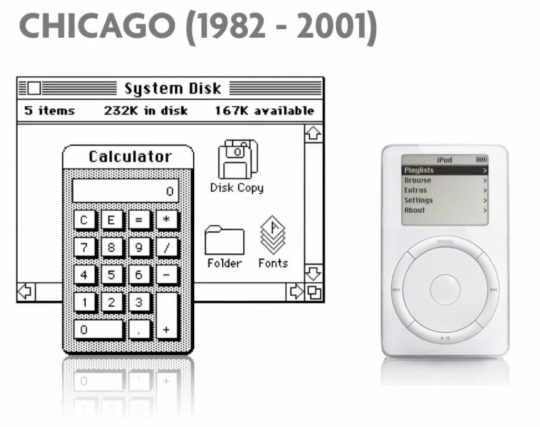
Susan Kare, Chicago Typeface for Macintosh Operating System (1982). Image source.
After working at Apple NeXT, Inc. Kare continued to work on a variety of projects including designing icons, typefaces, and user interface elements for a number of other technology companies including Microsoft, IBM, Sony Pictures, and Intel. (3) Kare also established her own company, Susan Kare Design and continues to work as a graphic designer and artist. (5) “The Museum of Modern Art (MoMA) store in New York City has carried stationery and notebooks featuring her designs” (4).
Ms. Kare's influential work has won several awards. In 1999, she was inducted into the Smithsonian's Cooper-Hewitt National Design Museum's National Design Awards Hall of Fame for Interface Design. (2) Her work was included in the Museum of Modern Art's (MoMA) 2011 exhibition "Talk to Me: Design and the Communication between People and Objects." In 2018, she was awarded the AIGA Medal, the highest honor in the field of graphic design in the United States. Ms. Kare has been a Creative Director at Pinterest since 2015. (5)
View Susan Kare's portfolio.
References
FamousGraphicDesigners.org, (2019). Susan Kare. Retrieved from: https://www.famousgraphicdesigners.org/susan-kare
Kindy, D., (9 October, 2019). How Susan Kare Designed User-Friendly Icons for the First Macintosh. Retrieved from:https://www.smithsonianmag.com/innovation/how-susan-kare-designed-user-friendly-icons-for-first-macintosh-180973286/
Wikipedia, (6 May, 2023). Susan Kare. Retrieved from: https://en.wikipedia.org/wiki/Susan_Kare
Christoph, (19 January, 2023). Susan Kare – Designing the GUI of the Apple Macintosh (and much more). Retrieved from: https://www.mac-history.net/2023/01/19/susan-kare-pixel-design-apple-mac/
Kare Prints, (2023). About Susan Kare. Retrieved from: https://kareprints.com/pages/about
3 notes
·
View notes
Text



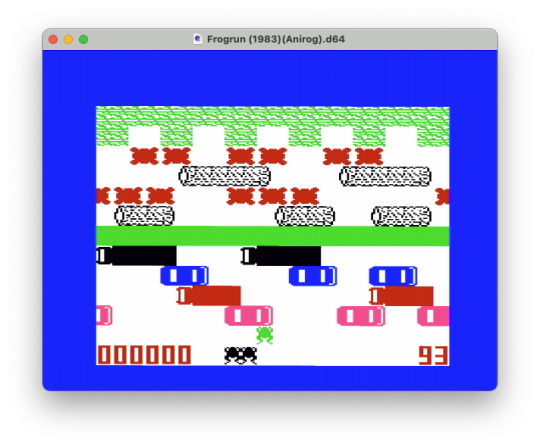
CLK 2023-12-26 - A latency-hating emulator of 8- and 16-bit platforms: the Acorn Electron, Amstrad CPC, Apple II/II+/IIe and early Macintosh, Atari 2600 and ST, ColecoVision, Enterprise 64/128, Commodore Vic-20 and Amiga, MSX 1/2, Oric 1/Atmos, early PC compatibles, Sega Master System, Sinclair ZX80/81 and ZX Spectrum.
#commodore#retro#amiga#vintage#classic#retrogaming#videogames#cbm#8bit#personal computer#vic-20#emulation#emulator#mac#apple
8 notes
·
View notes
Text
wacom tablet + Ventura: how to fix
If you, like me, have a wacom tablet and are using iOS Ventura, you may be having some problems :'D My wacom tablet has been weird ever since I got it, and recently it bugged out really bad and I couldn't even use it. Cue the panic! I emailed wacom and asked for help. The instructions they sent didn't work, but I have modified them and NOW THE TABLET WORKS. I don't think this software is stable and I think it's likely to bug out again, but at least if it does, I know what to do.
Googling around I see a lot of people are having this problem so I hope with enough tags and google-able words, I can help someone else.
Instructions under the cut.
If your wacom uninstaller isn't working (maybe it freezes, like mine did), skip step 2 and go from step 1 to step 3.
The following is word for word instructions from wacom with some alterations from me.
1. First, disconnect the tablet from the computer.
2. Next, open Finder, click on Go (at the top of the screen near the Apple menu) and go to Applications. Locate any Wacom Tablet folder and open the Wacom Tablet Utility in it. Using this utility, please remove All User's preferences and uninstall the driver. (Click on the lock icon on the bottom of the window to enable this option. Make sure to create a back up of your preferences first if necessary.)
Restart the computer.
3. After removing the driver with the utility, please manually check if anything was left behind. Please open Finder, click on Go, and then click on Computer. Once there, please access your main hard drive (by default should be named Macintosh HD) and check if anything is left behind in the folders listed below. DELETE EVERY WACOM-RELATED FILE IN THESE FOLDERS, not just the ones listed below. Check every file name carefully. Obliterate anything with "wacom" in the name. You may or may not have all the files listed below:
In Macintosh HD:
Applications/Wacom Tablet
Library/Application Support/Tablet
Library/Frameworks/WacomMultiTouch.framework
Library/Internet Plugins/WacomTabletPlugin.plugin
Library/Launch Agents/com.wacom.wacomtablet.plist
Library/LaunchDaemons/com.wacom.displayhelper.plist
Library/LaunchDaemons/com.wacom.RemoveTabletHelper.plist
Library/LaunchDaemons/com.wacom.TabletHelper.plist
Library/PreferencePanes/WacomTablet.prefpane
Library/Preferences/Tablet
Library/PriveledgedHelperTools/com.wacom.RemoveTabletHelper
Library/PriveledgedHelperTools/com.wacom.TabletHelper
❗️ If you have more than one user on your computer, you will have to repeat this for every user. If you do not have more than one user on your computer, ignore this part.
This part is for if there is more than one user on the computer, which currently there is not
The same will have to be checked in any respective User’s folder on the system. To access it, you must select 'Go' from the top of Finder and select 'Go to folder...’. Here, enter ~/Library to access the current user's Library folder. Please check for Wacom related files in the Preferences folder and remove them if present:
Users/<your user>/Library/Preferences/com.wacom.ProfessionalTablet.plist
Users/<your user>/Library/Preferences/com.wacom.wacomtablet.prefs
Users/<your user>/Library/Preferences/com.wacom.wacomtouch.prefs
❗️ End of instructions for other users
Restart the computer.
4. Open Finder, go to Applications and then in Utilities. Please open the Disk Utility and use the First Aid tool to do a repair of your disk permissions.
5. Now download and install the latest driver from wacom. Search based on your tablet product number. Be sure to give permissions to the driver as they are requested during this installation process.
6. Once the installation is complete, and the system is stable, connect the tablet. As always, make sure your tablet is connected directly to your computer. Avoid using USB hubs, keyboard/monitor ports, or docking stations with the tablets, as they can cause inconsistent behavior.
THINGS TO MAKE SURE ARE ON:
System Settings → Privacy and Security → Accessibility → make sure all wacom-related things are turned on (“com.wacom” and “WacomTabletDriver” on my computer)
System Settings → Privacy and Security → Input Monitoring → make sure all wacom-related things are turned on (“WacomTabletDriver” on my computer)
If the above wacom things disappear, you can find them in:
Go → Applications → Wacom Tablet → push “cmd shift period” keys to show the hidden folder .Tablet → .Tablet has the driver things, you can drag them into the Accessibility and Input Monitoring panels
These instructions are relevant as of posting (Feb 5, 2023). If you find something has worked/doesn't work for you, feel free to put it in the notes or a reblog. I'm not an IT person. I just want people to be able to use their very expensive equipment 😫
#wacom#wacom tablet#troubleshooting#ventura#wacom ventura#plz wacom fix this#it's not just me#there's pple on reddit talking about this#def a wacom + ventura problem#it's scary when your tablet crashes your computer#I almost lost some stuff#makes your heart stop in your chest#so let's fix it!!
5 notes
·
View notes
Text
EVOLUCIÓN DE LA INTERFAZ GRÁFICA DE USUARIO
EVOLUCIÓN HISTORICA
Las tecnologías de información tuvieron su comienzo en la guerra fría. Sin embargo tuvo un enorme avance en el periodo post guerra que dejo la Segunda Guerra Mundial.
El gobierno de los Estados Unidos buscaba formas de manejar los adelantos de la tecnología y la información de sus computadoras de tal manera que una bomba nuclear no acabara con sus centros de datos.

Las computadoras e interfaces gráficas de usuario han evolucionado junto a la tecnología.
ARPANED 1958
• Las computadoras eran grandes calculadoras/ hardware complejos/ manejo complejo especializado.
RED MUNDIAL 1960
• Simbiosis HOMBRE-COMPUTADORA- Joseph Carl Robnett Licklider.
• Primer mouse/ “X-Y position Indicator for a Display System ”
• Primera interfaz gráfica.
• Primer sistema de hipertexto.
ARRANCA ARPANET 1969
• Primer enlace exitoso/ 10:30 PM, Octubre 29, 1969/ enlace entre 2 laboratorios a 500 km de distancia.

INTERNET 1970
• International Network.
• Vinton Cerf/ Uno de los actores más importantes en la liberación de internet al público general/ 1970 habla de la red internacional y de las posibilidades de la conexión global.
CORREO ELECTRÓNICO 1971
• Ray Tomlinson.
• Primer email: QWERTYUIOP
MICROSOFT 1975
• Bill Gates y Paul Allen.
• 80s/ domina el mercado de las computadoras personales.
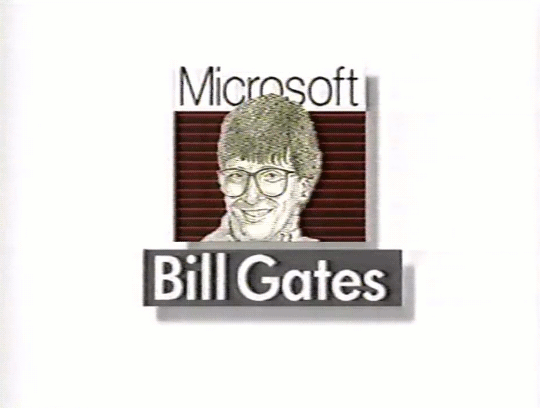
APPLE 1976
• Steve Jobs y Steve Wozniak
• La Apple/ vendió 200 copias.
• Xerox Star/ primer GUI comercial/ versión mejorada del mouse por XEROX PARC.
• Xerox Alto 1973/ primera computadora en utilizar la METÁFORA DE ESCRITORIO.
EL PARADIGMA DEL PAPEL
• Texto negro, fondo blanco, el área de trabajo como el papel blanco.
• Folders, hojas y el escritorio.
• Apple Lisa 1979.
DE LA INTERFAZ GRÁFICA A LA INTERFAZ HUMANA
• Apuesta por la informática intuitiva y amigable.
• Jeff Raskin/ Steve Jobs
• El concepto de la primera MACINTOSH se mantiene hasta hoy/computadoras herméticas/ simplicidad y minimalismo en el diseño.
• Eliminar lo totalmente imprescindible.
LA METÁFORA DEL ESCRITORIO
• GUI de Microsoft Windows 1985.

PRIMERA PC MULTIMEDIA 1985
• AMIGA 1000
• GUI de NeXT Computer/1990/ fundada por Steve Jobs luego de ser despedido de Apple en 1985.
• Logotipo diseñado por Paul Rand/ la anécdota cuenta que el logotipo costo $us 100,000.
HIPERTEXTO 1991
• Tim Berners-Lee
• Del texto al Hipertexto.
• Protocolo HTTP
• Mac OS 9.1/ 1999

• Windows 95/ 1995
• Apple Mac OS X/ 2002 / Al retornar Steve Jobs trae consigo el núcleo de NeXT Computers y el concepto de computadoras destinadas a la producción gráfica y artística.
• Windows XP 2001
• En 2012 tenia una cuota de mercado del 46.33%
• El sistema gráfico busca representar una interfaz familiar y amigable.
• Windows Vista 2007.

• Apple llega al punto más alto de la sofisticación gráfica con su sistema Snow Leopard.
• Reflejos y brillos hiperreales/ este lenguaje hiperreal ha sido nombrado como SKEUMORFISMO.
• Los reproductores de MP3 permitían almacenar 25 canciones en un formato limitado de 100 Mb.
• La piratería era un serio problema para la industria musical/ plataformas como NAPSTER/ transmisión de datos P2P.
• Canciones a $1, a través de ITunes y reproducibles en sus nuevos dispositivos IPod.
• Surge la telefonía celular/ marcas y dispositivos plantean un nuevo mercado de comunicaciones.
• La metáfora del escritorio es trasladada a un entorno más pequeño.
• El concepto de teléfono inteligente se iba formulando.
• IPhone 1/ 2007/ primer teléfono inteligente.
• La resolución de los celulares supera a la de los computadores de escritorio.
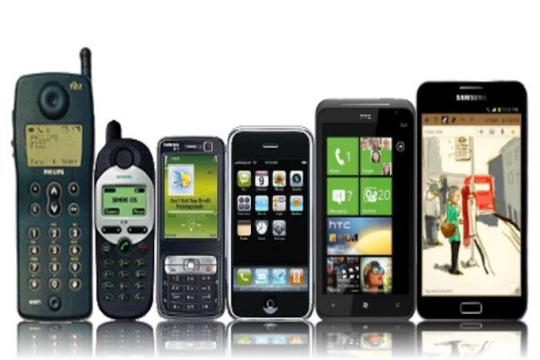
La evolución a causado que existan diversas interfaces. ¿Hasta que punto podremos llegar?.

5 notes
·
View notes
Note
fuck it. my rq is that uhhhhh,,,, please tell me facts about the 80s :)
^ Asks that make Cowboy, as a grown ass man, go "TEEHEE"
Well for one the shirt I linked in that fashion post was actually one of the most popular brands to wear in the 80s, which is why I sought it out. (Also: I had to search for the past term for seek. :( )
I'm kinda bad at thinking of things for such broad topics, but let's see, what's some fun stuff I know...
Well, I know personal computers first started becoming really popular in the 80s. Before that, they were machines that took up entire rooms and weren't something you'd find in anyone's home, but smaller, more public-friendly versions started coming into the market in the late 70s and experienced a boom during the 80s.
One of my favorite computers of the 80s is the Amiga, which is kind of a basic 80s computer to like, but... look at it!

It was pretty much, as far as I know, at least one of the best computers of its time, with a sleek, unique, and fast-loading system, a lot more RAM than its competitor the C64, amazing and vibrant visuals the likes of which had pretty much never been seen on a personal computer before, more hardware capabilities, better multitasking... basically it was a dream machine. The line also has one of my favorite UIs:

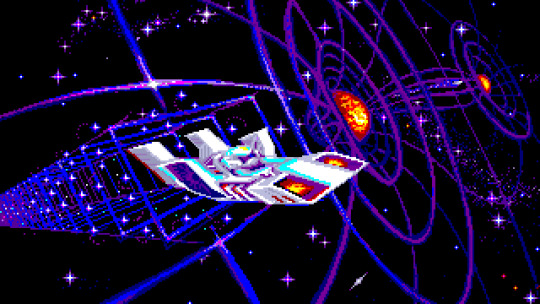
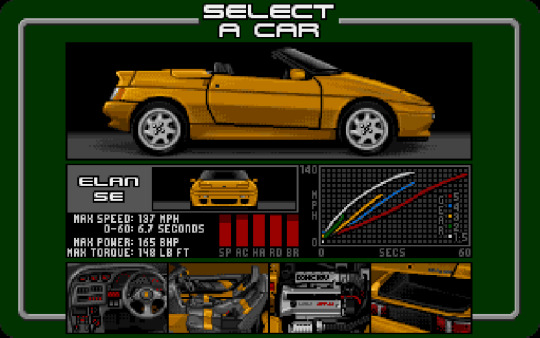

Check out how awesome these graphics are! The Amiga boasted games like The Secret of Monkey Island, Lemmings, Bubble Bobble, and the original Sid Meier's Civilization.
Of course, they went bankrupt in the 90s, after attempting and utterly failing to market the Amiga as a gaming console. IBM, Apple, and Windows were also coming out with computers around that time, with the first MacIntosh coming out in 1984 and Windows 1 (which was among the first to require the use of a mouse for input, rather than the keyboard!) coming out a year later in 1985.
LGR on YouTube has a lot of cool videos about 80s computers that I'd recommend checking out - he's also a lot better at memorizing facts and knowing things about computers than I am, lol. I'm not good at any of the technical stuff. In fact, I can't promise I'm remembering everything correctly here - I'd recommend looking into this stuff if it interests you, the boom of personal computers and technology in general in the 80s is really cool. But anyways...
Speaking of computers, the first music video to use CGI came out in 1985, that being Dire Straits' Money For Nothing. Check it out -
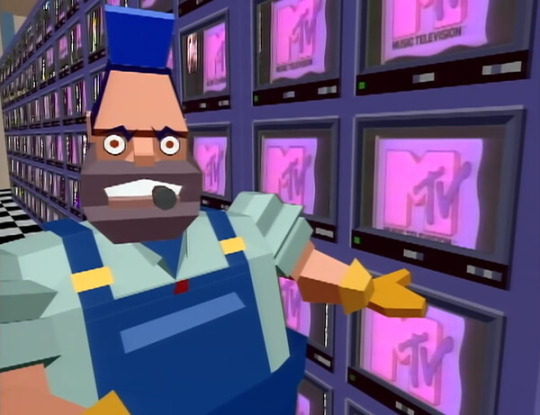
It was even referenced in an episode of a show called ReBoot, which I'd also love to talk about, but came about in the 90s. (There was some SERIOUSLY COOL CGI in the 90s! Early CGI stuff is SO AWESOME, it's so cool to see how far it's come and to think about how awesome it must have been to see something like this when it came out!) And with MTV coming out in the 80s too (1981), this probably made a pretty great impression and, I imagine, was one of the most interesting MVs on TV at the time! It's certainly one of my favorites, and in fact, I love the song, too.
The first music video on MTV, fittingly, was Video Killed the Radio Star, presented after the channel came on air with the iconic line: "Ladies and gentlemen, rock 'n roll!"
I could ramble a lot about the music and movies of the time, especially horror and practical effects, but this post is already pretty long and totally unrelated to this blog. There were a lot of technological advancements and huge cultural impacts made in the 80s that we see and use (or at the very least see the effects of) to this day, and discoveries made and researches done, and really awesome subcultures and fashions, like trad goth and skate punk and New Romantics my beloved and, and, and-- and th. And. The. And. And. 😍💓💞💖🥰❣️💝💘💞😍💘❣️💓💘❣️💗

3 notes
·
View notes
Text
Simcity 2000 download windows 10 dosbox

#Simcity 2000 download windows 10 dosbox install
Finally, instead of the poll in the first game you now have the option of reading several newspapers to get an idea of your progress. It has all the features, flexibility, art. You can now give names to places, and your city is surrounded by neighboring towns with which you can make trade. Now you can design any city you can imagine and SimCity 2000 will bring it, and its resident Sims, to life. For certain games, you will also need Wine.
#Simcity 2000 download windows 10 dosbox install
If you are using Ubuntu or any other Debian based distribution, simply use the apt command below to install the DOSBox package. This title adds numerous features over the original such as the ability of building "light" zones, subways, hospitals, colleges, zoos, and arcos which are actually cities in cities. SimCity 3000 Maxis SimCity 3000 With SimCity 3000, you have more power than ever before to build and control your city Recreate your version of the worlds greatest cities. In order to play a DOS game on a Linux Operating System, we first need to install the DOSBox simulator. The graphics are isometric, whereas the original had graphics displayed in a top-down fashion. You are once again the mayor, but this time you can fully customize the terrain before building your city. It was later released on the Amiga, DOS & Microsoft Windows, followed by a release for OS/2. Is there any place you can buy SimCity 2000 that works on Windows 10 64 bit Edit: Specifically looking for the Windows 95 version, not DOS which is sold at origin and GOG. SimCity 2000 was first released by Maxis in 1994 for computers running Apple Macintosh Operating System. SimCity 2000 is the successor to the ground breaking city simulation game Sim City. About Sim City 2000: SimCity 2000 (SC2K) is a city-building simulation video game and the second installment in the SimCity series. Develop and build your own city! This collection includes SimCity 2000, SimCity 2000 Scenarios Volume 1: Great Disasters, SimCity 2000 Bonus Cities and Scenarios, and the Urban Renewal Kit which allows you to build your own cities free of charge and them import them into the game!

2 notes
·
View notes